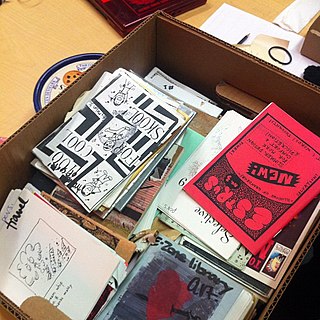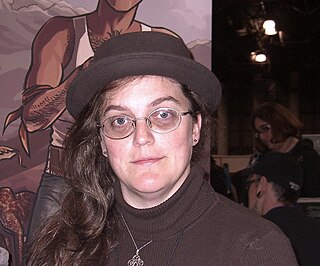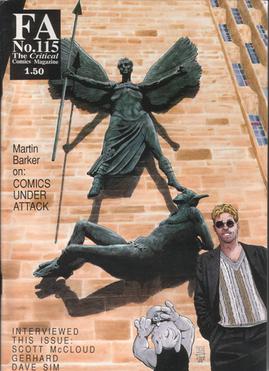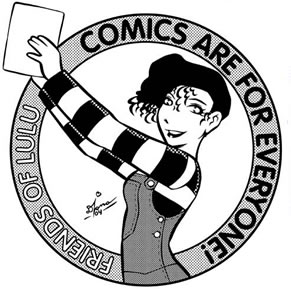
A zine is a small-circulation self-published work of original or appropriated texts and images, usually reproduced via a copy machine. Zines are the product of either a single person or of a very small group, and are popularly photocopied into physical prints for circulation. A fanzine is a non-professional and non-official publication produced by enthusiasts of a particular cultural phenomenon for the pleasure of others who share their interest. The term was coined in an October 1940 science fiction fanzine by Russ Chauvenet and popularized within science fiction fandom, entering the Oxford English Dictionary in 1949.

Carla Speed McNeil is an American science fiction writer, cartoonist, and illustrator of comics, best known for the science fiction comic book series Finder.
A Softer World is a webcomic by the writer Joey Comeau and artist Emily Horne, both Canadians. It was first published online on 7 February 2003 and was released three times a week until its end in June 2015. Before starting the website in 2003, the comics had been published in zine form. With the launch of the website, the comic gained wider recognition, most notably when Warren Ellis linked to the comic on his blog, and then began to feature it as a "Favored Puny Human". It appeared in The Guardian for a short time until a change of editors caused it to be removed. Between 2008 and 2010, science fiction-themed strips of A Softer World were also produced and published on Tor.com.

Jill Thompson is an American illustrator and writer who has worked for stage, film, and television. Well known for her work on Neil Gaiman's The Sandman characters and her own Scary Godmother series, she has worked on The Invisibles, Swamp Thing, and Wonder Woman as well.
Girlamatic was a webcomic subscription service launched by Joey Manley and Lea Hernandez in March 2003. It was the third online magazine Manley established as part of his Modern Tales family of websites. Girlamatic was created as a place where both female artists and readers could feel comfortable and featured a diverse mix of genres. When the site launched, the most recent webcomic pages and strips were free, and the website's archives were available by subscription. The editorial role was held by Hernandez from 2003 until 2006, when it was taken over by Arcana Jayne-creator Lisa Jonté, one of the site's original artists. In 2009, Girlamatic was relaunched as a free digital magazine, this time edited by Spades-creator Diana McQueen. The archives of the webcomics that ran on Girlamatic remained freely available until the website was discontinued in 2013.

Trina Robbins is an American cartoonist. She was an early participant in the underground comix movement, and one of the first female artists in that movement. She is a member of the Will Eisner Hall of Fame.

Maggie Thompson, is an American longtime editor of the now-defunct comic book industry news magazine Comics Buyer's Guide, science fiction fan, and collector of comics.
Laura DePuy is a colorist who has produced work for several of the major comics companies, including DC Comics, Marvel Comics and CrossGen.

Fantasy Advertiser, later abbreviated to FA, was a British fanzine focused on comic books, founded in 1965 by Frank Dobson, the "Godfather of British Fandom." Starting out as an adzine focused on the sale of primarily second-hand comics, it eventually transitioned into a true comics fanzine. FA now operates as a comics webzine.

Friends of Lulu (FoL) was a non-profit, national charitable organization in the United States, designed to promote readership of comic books by women and the participation of women in the comic book industry. FoL operated from 1994 to 2011.
Lea Hernandez is an American comic book and webcomic creator, known primarily for working in a manga-influenced style, and for doing lettering and touch-ups on manga imports. She is the co-creator of Killer Princesses, written by Gail Simone and published by Oni Press; and the creator of Rumble Girls from NBM Publishing.
Dorothy Woolfolk née Dorothy Roubicek was one of the first women in the American comic-book industry. As an editor at DC Comics, one of the two largest companies in the field, during the 1940s period historians and fans call the Golden Age of Comic Books, she is credited with helping to create the fictional metal Kryptonite in the Superman mythos.
Comic Festival was a British comic book convention which was held annually in Bristol between 1999 and 2004. It was devised and produced by Kev F. Sutherland with the help of Mike Allwood of Area 51 Comics.

Barbara Randall Kesel is an American writer and editor of comic books. Her bibliography includes work for Crossgen, Dark Horse Comics, DC Comics, IDW Publishing, Image Comics, and Marvel Comics.

Sarah Dyer is an American comic book writer and artist with roots in the zine movement of the late 1980s and early 1990s.
The portrayal of women inAmerican comic books has often been the subject of controversy since the medium's beginning. Critics have noted the roles of women as both supporting characters and lead characters are substantially more subjected to gender stereotypes, with femininity and/or sexual characteristics having a larger presence in their overall character.

Our Gods Wear Spandex: The Secret History of Comic Book Heroes is a 2007 book by Christopher Knowles, the former editor of Comic Book Artist, with illustrations by Joe Linsner.

The Comic Reader (TCR) was a comics news-fanzine published from 1961 to 1984. Debuting in the pre-direct market era, TCR was the first regularly published comics industry news fanzine, and was able to secure many contacts from within the ranks of the larger publishers. As TCR increased in popularity and influence, it was able to attract professional artist to illustrate the covers. TCR also proved to be a launching pad for aspiring comic book creators, many of whom published work in the fanzine as amateurs. Contributors from the world of fandom included founding editor Jerry Bails, key editor Paul Levitz, Paul Kupperberg, Tony Isabella, Byron Preiss, Neal Pozner, Don Rosa, Carl Gafford, and Doug Hazlewood.
Suzy Varty is a noted British comics artist, writer, and editor. In the late 1970s, she compiled, contributed to and edited Heröine, the first anthology of comics by women to be published in the U.K. Throughout the 70s, she was part of the Birmingham Arts Lab, and she has participated in the Underground Comix and Wimmen's Comix movements in the U.S. Varty remains active in the British Comics scene, frequently appearing at such conventions as Thought Bubble Comic Arts Festival in Leeds and the Canny Comic Con in Newcastle.











